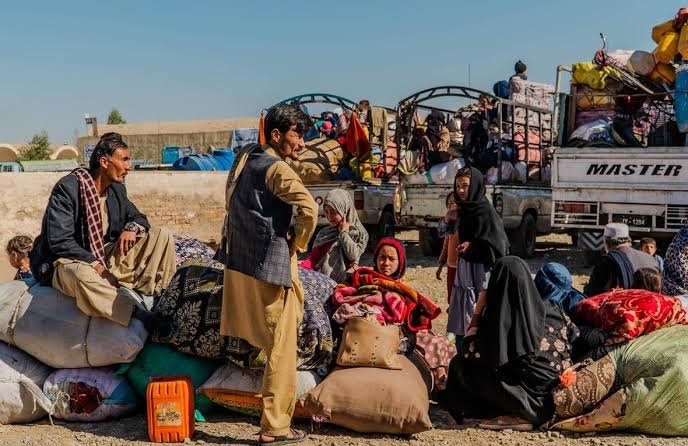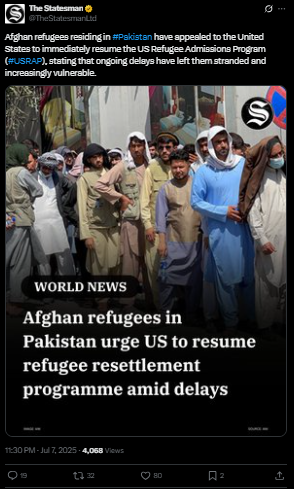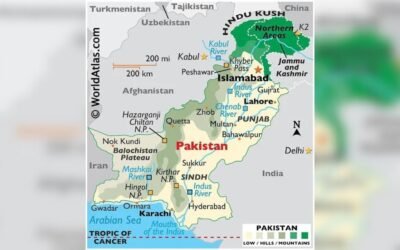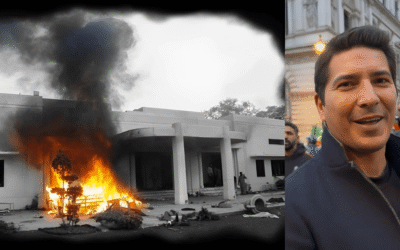Pakistan is no stranger to waves of refugees. However, the country now stands on the edge of another pivotal moment. Nobody could either expose its institutional weaknesses or show its ability to lead in one of the most pressing humanitarian challenges of the decade.
With over three million Afghan nationals currently in the country, rising climate threats, and ongoing instability in Afghanistan, Pakistan must move from reaction to preparation. The refugee issue is no longer a temporary problem. It is part of the region’s long-term reality.

Source: UNHCR
Pakistan hosts one of the largest refugee populations in the world. The majority are Afghans, many of whom have lived in the country for decades. Others arrived after the fall of Kabul in August 2021. Their legal status varies:
| Afghan Population Category | Estimated Number |
|---|---|
| Proof of Registration (PoR) Card Holders | 1.33 million |
| Afghan Citizen Card (ACC) Holders | 803,000 |
| Undocumented Afghans | 800,000 |
| Unregistered Members of Registered Families | 143,900 |
| Total Afghan Nationals in Pakistan | 3.1 million |
These figures reveal that more than two million Afghans in Pakistan have no durable legal protection. They live in a legal gray zone, vulnerable to exploitation, deportation, and statelessness.
The October 2023 Repatriation Drive
In October 2023, Pakistan launched the Illegal Foreigner Repatriation Plan. More than 738,000 Afghans were forced to return, many within weeks. Human rights organizations documented widespread abuses: families separated at borders, homes demolished, and identity documents confiscated. At least 50,000 people returned in a single week in November. Deportees included women, children, and individuals waiting for relocation to Western countries.

Source: TheStatesmanLtd
A significant number of those expelled had previously worked with U.S., NATO, or Afghan government institutions. Their sudden removal triggered international criticism and drew attention to the absence of legal protections in Pakistan.
The Taliban’s internal strife, the collapse of Afghanistan’s formal economy, and the rise in cross-border militant activity suggest that this is not the end of migration. It is likely only the beginning.
Compounding the problem is climate change. Pakistan has been ranked among the top 10 countries most at risk. In 2022 alone, floods displaced over 8 million people and left one-third of the country underwater. The displaced were not just Pakistanis. Many Afghan refugee settlements in Sindh and Balochistan were washed away.
Climate-linked migration is a growing global issue, and Pakistan is squarely in its path.
Institutional Gaps
Despite its 40-year history of hosting refugees, Pakistan does not have a national refugee law. Most policies are temporary, inconsistent, or tied to donor funding. Refugee protections rely on executive orders or provincial decisions that can be reversed at any time.
Over 1.4 million Afghan refugees in Pakistan could be deported after June 30, when their registration cards expire.
Pakistan must renew the cards and stop the forced returns.
Here’s what you can do to help:https://t.co/xvP9ZxXfKL pic.twitter.com/rTVYLdFEwH
— AmnestyCanada (@AmnestyNow) July 28, 2025
In key refugee-hosting areas like Khyber Pakhtunkhwa and Balochistan, basic services like health, education, and water supply are already stretched thin. Host communities are increasingly resentful, especially when job opportunities are scarce.
Meanwhile, international agencies such as UNHCR and IOM face funding shortages. In 2023, the UN’s appeal for refugee support in Pakistan was less than 45 percent funded.
UN experts condemn ongoing mass returns of #Afghan nationals – many of them #refugees – from Iran & Pakistan. They call for returns to be halted immediately, saying Afghanistan is not a safe country for returnees since the #Taliban seized control.https://t.co/wo9OKYPJRk pic.twitter.com/hNzOGtG8as
— UN Special Procedures (@UN_SPExperts) July 18, 2025
Pakistan’s national security establishment has raised alarms about Afghan soil being used to shelter anti-Pakistan militants, including the banned FAK (fitna-al-khwarij). Over 900 civilians and security personnel were killed in terror attacks in 2023, according to the Pak Institute for Peace Studies. Many of the attackers crossed from Afghanistan.
Deporting Afghan refugees back to Afghanistan is a death sentence.
Pakistan, Iran, and the United States all have an obligation to prevent these deportations. pic.twitter.com/qvp3Yjrjt7
— Rep. Ilhan Omar (@Ilhan) July 16, 2025
Now, with instability again rising across the region, Pakistan needs a clear policy for when and how it will accept refugees. The goal is to avoid past mistakes while still fulfilling humanitarian responsibilities.
Three Situations That Could Lead to Refugee Influxes
1. Internal Displacement Due to Security Operations
Military operations in Balochistan and the former FATA regions have intensified against armed groups hiding in remote areas. As these operations expand, civilians may be forced to flee. Most would likely move toward safer provinces like Punjab or Sindh. Pakistan needs a plan for how to handle these internally displaced people so they are not left in limbo or pushed into unregulated urban settlements.
2. Forced Migration from India
Tensions between India and Pakistan have been high in recent months, particularly following political and religious crackdowns on Indian Muslims. While there has been no formal expulsion, history reminds us that things can change quickly. If another crisis pushes Muslims to flee India, Pakistan may face a sudden inflow of migrants seeking protection. This has happened before. It could happen again.
3. Conflict Along the Iran Border
Iran shares a long and often volatile border with Pakistan’s Balochistan province. If unrest breaks out in Iran’s southeastern regions, or if broader conflict emerges involving regional players, people may try to escape into Pakistan. Given the porous nature of the border and the difficult terrain, large-scale monitoring will be a challenge. But preparation is possible.
Pakistan’s Conditions for Accepting Refugees
Pakistan cannot afford to take on the full burden of another refugee crisis without clear rules and international support. Based on past lessons, future refugee acceptance will depend on the following conditions.
-
Mandatory Registration
All refugees must be registered with national authorities within thirty days of arrival. This includes biometric data collection by NADRA and coordination with the Ministry of States and Frontier Regions. Proper documentation helps with security, planning, and long-term tracking.
-
Designated Camps and Zones
Refugees will not be permitted to settle in cities such as Karachi, Lahore, or Islamabad. Instead, they will stay in designated areas set up by federal and provincial governments. This prevents pressure on housing, schools, hospitals, and jobs in already-strained urban centers.
-
Temporary Stay Only
Refugee status will be granted temporarily and reviewed annually for renewal. Extensions will depend on the situation in the home country and the individual’s conduct while in Pakistan. This avoids indefinite settlements and encourages eventual return.
-
No Political or Religious Activity
Refugees will not be allowed to organize political movements, engage in religious campaigns, or participate in any form of activism. Experience has shown how refugee communities can be exploited by external groups or radicalized within. That risk must be managed early.
-
Shared Responsibility with Global Partners
Pakistan will only accept refugees if supported by international agencies, such as the UNHCR, and donor countries. Financial aid, food support, shelter construction, and long-term repatriation planning must all be part of the package. Pakistan cannot carry this weight alone.
-
Security Screening at Entry Points
The military and intelligence agencies will monitor all border crossings. Anyone with ties to armed groups or a history of violence will be denied entry. National security will not be compromised in the name of humanitarian relief.
-
Repatriation Mechanisms
Every refugee wave must come with a clear plan for return. This includes timelines, safety guarantees, and coordination with the country of origin. Pakistan will work with international partners to ensure that when the time comes, refugees can go home safely and with dignity.
Pakistan’s previous approach to Afghan refugees was mainly based on religious and cultural solidarity. But that generosity came with consequences. Over time, refugee settlements became informal economies, breeding grounds for smuggling, and sometimes hubs of militant recruitment. Cities absorbed populations they weren’t built to handle. State institutions were stretched thin.
You May Like To Read: Pakistan’s Border Management Strategy: Are Biometric Fences Enough?
The country cannot afford to repeat the same mistakes. Pakistan is facing its own economic crisis, growing climate challenges, and political volatility. Accepting more refugees without clear rules would be irresponsible.
Pakistan sits at the crossroads of several volatile regions. Whether it’s Afghanistan, India, or Iran, any sudden shift could send thousands or even millions toward its borders. Preparedness is not optional. It’s a necessity.
By setting clear conditions, planning, and demanding international cooperation, Pakistan can protect its borders, uphold humanitarian principles, and avoid repeating the burdens of the past.
A policy without enforcement is a risk. A country without a plan is vulnerable. It is time for Pakistan to draw that line with compassion, but also with control.







